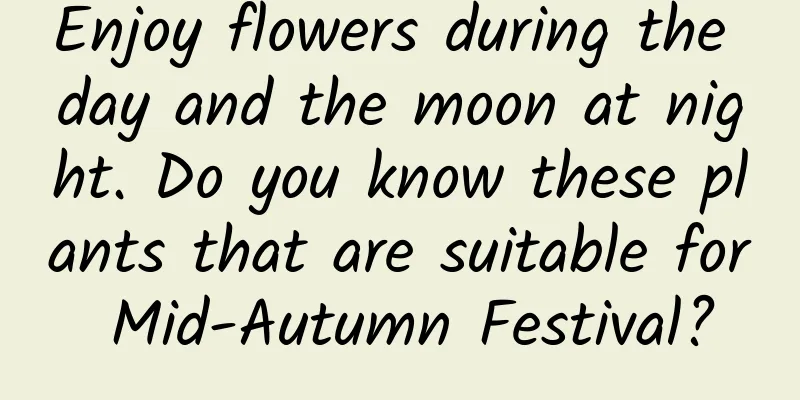Enjoy flowers during the day and the moon at night. Do you know these plants that are suitable for Mid-Autumn Festival?

|
Review expert: Xia Xiaofei, deputy director of the specimen department of Beijing Museum of Natural History Member of Beijing Municipal Science and Technology Commission's Science Popularization Expert Database The annual Mid-Autumn Festival is here again. Are you sitting on the terrace now, enjoying tea and watching the moon? In the cool autumn night with full moon, sitting together with your family, sipping a cup of fragrant osmanthus tea, tasting a piece of sweet moon cake, and the faint fragrance of chrysanthemums wafting around you... Does this scene satisfy all your imaginations of autumn nights? Source: pixabay Every Mid-Autumn Festival, in addition to the moon, our topic is always inseparable from seasonal flowers such as osmanthus and chrysanthemum. In the legend, there is always a osmanthus tree in the Moon Palace. What is the relationship between this osmanthus tree and the osmanthus tree in reality? We also know that there is a plant called "laurel". Is it the same plant as osmanthus? In addition to osmanthus, what other plants are related to Mid-Autumn Festival and the moon? Today, let’s talk about the plants related to Mid-Autumn Festival and the moon. When it comes to autumn , we can’t leave out osmanthus and osmanthus trees. Osmanthus is a general term for the flowers of various plants in the genus Oleaceae. The osmanthus that we see in daily life generally refers to the flowers of Osmanthus fragrans, which are distributed wild from India to China and southern Japan. Osmanthus has many other names, such as osmanthus, thorny osmanthus, and laurel. Osmanthus fragrans Source: Wikipedia Osmanthus fragrans has a unique fragrance and is one of China's traditional flowers. It has the functions of greening, beautification and fragrance. Since ancient times, there have been records of osmanthus cultivation in China. Yang Wanli of the Song Dynasty said: "It is not planted by humans, but moved from the moon; a little fragrance from Guanghan blows the whole mountain into bloom." In the long-term planting and breeding, osmanthus has gradually formed four major categories: Osmanthus fragrans, Osmanthus fragrans, Osmanthus fragrans and Osmanthus fragrans . In the south, osmanthus is usually planted in the courtyard, while in the north, it is mostly planted indoors in pots, or planted outdoors and built into a greenhouse for wintering. Osmanthus fragrans Source: Wikipedia As autumn approaches, osmanthus gradually enters its peak flowering period, just in time for the Mid-Autumn Festival. For this reason, osmanthus has become an indispensable landscape during the Mid-Autumn Festival. Osmanthus has a very strong fragrance. In addition to being used for ornamental purposes, it is also widely used in the production of traditional cakes, teas, dishes and other foods. It is also widely used as a spice and medicine, and is also used as a raw material for brewing wine. Every Mid-Autumn Festival, traditional delicacies such as osmanthus cakes, osmanthus wine, and osmanthus candy are all on the market. Even those who don't usually like the smell of flowers often find it difficult to resist the sweet-scented osmanthus fragrance floating on the streets. Osmanthus Cake Source: Baidu Encyclopedia The laurel tree is always associated with the moon. According to legend, Wu Gang was punished by the Emperor of Heaven to chop down the laurel tree in the Moon Palace, but the tree healed as soon as it was chopped down, and it could never be chopped down. This legend is not only in China, but also spread to Japan with the cultural exchanges between ancient China and Japan. Therefore, when a shrub native to the Mediterranean region was introduced to Japan during the Meiji period, it was believed to be the laurel tree in the legendary Moon Palace because of its appearance and strong fragrance of leaves, and was named "laurel". In fact, laurel (Laurus nobilis) belongs to the genus Laurus of the Lauraceae family, and is distantly related to the laurel of the Oleaceae family. The reason why the two have similar names is probably that the early translators directly took the Japanese kanji for "laurel". In Greek mythology, this tree represents "the glory of Apollo", and the wreath woven from its branches is what we often call "laurel wreath". In addition, the leaves of laurel are dried and become the scent leaves we often use when stewing meat. A small bay laurel Source: Wikipedia It is worth mentioning that in my country, osmanthus is sometimes called "laurel". There is also a horticultural variety called "laurel". Don't confuse it with the real laurel. Chrysanthemum and Miscanthus The custom of appreciating chrysanthemums in autumn has existed since ancient times. From the inner court of the imperial palace to the homes of ordinary people, chrysanthemum appreciation activities are held when chrysanthemums are in full bloom in autumn. Although chrysanthemums are not as closely associated with the Mid-Autumn Festival as osmanthus flowers are culturally (in traditional culture, chrysanthemums are often more closely associated with "autumn" rather than "Mid-Autumn Festival"), autumn chrysanthemums are still a sight that cannot be missed during the Mid-Autumn Festival. Chrysanthemums in autumn Source: Wikipedia Chrysanthemum (Chrysanthemum × morifolium) is a perennial herbaceous plant of the Asteraceae family, which was bred by hybridization of wild chrysanthemum and other plants of the genus Chrysanthemum. Although chrysanthemums are in full bloom from early summer to January of the following year, when people mention chrysanthemums, they often think of the golden sea of flowers in mid-autumn. Japan's traditional Mid-Autumn Festival is called "Fifteen Nights". The concept of Mid-Autumn Festival was introduced to Japan around the Tang Dynasty. With the development of the times, it gradually changed from a unique enjoyment among the nobility to a very popular activity for everyone from the royal family to the common people. Mochi dumplings, chestnuts and silver grass are displayed during moon-viewing in Japan Source: Wikipedia In Japanese culture, there is a plant that is also closely related to moon-watching, and that is Miscanthus. Unlike in China, the reason why Japanese moon-watching activities place Miscanthus is that on the one hand, they use Miscanthus to replace the unripe rice ears during the Mid-Autumn Festival to worship the moon, and on the other hand, they believe that the sharp cut left after cutting the Miscanthus can bring good luck and avoid bad luck. Various "Beauty Under the Moon" Now that we have looked at these ornamental plants that are traditionally associated with autumn and Mid-Autumn Festival, let’s get to know some flowers that are associated with the moon. 1. Moonlight Beauty The beauty under the moon is Epiphyllum oxypetalum. It belongs to the genus Epiphyllum in the cactus family and is an epiphytic succulent shrub. The epiphyllum is very beautiful, but its flowering period is very short, and it mostly blooms at night and withers the next morning, so it has the title of "Beauty under the Moon". Epiphyllum Source: Wikipedia 2. Moonflower Moonflower (Ipomoea alba), also known as evening primrose, is a plant of the genus Ipomoea in the family Convolvulaceae. It is closely related to morning glory. The flowers of moonflower are very similar to morning glory, but much larger than morning glory, with a diameter of up to 14 cm. From a distance, its flowers are round and white, like a full moon, hence the name "moonflower". Moonflower Source: Wikipedia 3. Evening Primrose Evening primrose (Oenothera L.) belongs to the Onagraceae family, also known as evening primrose or evening primrose, with yellow and pink flowers as the main colors, and also red and white flowers. Most of these plants bloom only at night and wither during the day, so they were given such a name. Evening Primrose Source: Wikipedia 4. Succulents Among succulents, there are also many varieties named "moon", such as Longyue, Yinyue, Huayueye, Yuetuer, etc. The names of these succulents are related to the moon, probably because of the shape and color of their leaves. Hazy Moon Source: Wikipedia Moon rabbit ears (Gallanthus fasciatus) Source: Wikipedia Today we have counted many flowers and plants related to Mid-Autumn Festival and the moon. Speaking of this, you might as well look back at the flower pots in your home to see if you are also planting flowers related to the moon and Mid-Autumn Festival? |
<<: Popular Science Illustrations | What is Carbon Neutral Food?
>>: Is the jade rabbit on the moon the rabbit from Spicy Rabbit Head?
Recommend
Analysis and solutions for common rejection reasons of financial apps
The APP review here refers to the AppStore review...
A mathematical genius who cracked the German code during World War II took the secret with him
Code breaking played a key role in the war. Swedi...
[Single course encryption] Caixuetang Zhang Xiangyang's "Stock Market Big Dipper" is ready to learn and use, and is one step ahead in actual combat
[Single course encryption] Caixuetang Zhang Xiang...
22 Lectures of Go Language Evangelist's Getting Started Notes
Go has become the most competitive programming la...
Why do glasses become crooked when I wear them?
This article was reviewed by Dr. Tao Ning, Associ...
5-day learning plan of ancient beauty exercises, 5 minutes a day to remove wrinkles, lighten spots and fight aging
Every woman wants to be younger than her peers Sk...
When promoting an APP, is it correct to ask friends to forward it to their Moments?
I think many people have received messages like t...
Can data-driven operations really lead to rapid user growth?
As the saying goes, "Good wine needs no bush...
When the weather gets cold, you can eat fruits hot →
As the weather gets colder, friends who want a ba...
[Tai Er Pickled Cabbage Fish] How much is the franchise fee_How is Tai Er Pickled Cabbage Fish_Tai Er Pickled Cabbage Fish official website phone number
[Details of joining Taier Pickled Fish Franchise]...
The latest progress of Tencent and Alibaba's "interconnection": Taobao is testing WeChat payment and supports screenshot jump
"Interconnection and interoperability" ...
Android high imitation taxi and other software project source code
Source code introduction This project is modeled ...
How to view private domain traffic, live broadcasts by internet celebrities, IP, and knowledge payment?
In 2020, how should we view the development and d...
Community Operation SOP Construction Methodology
This content will share the methodology of SOP fr...
Weibo Fans Advertising Case Study: Beauty and Plastic Surgery Industry!
Shanghai Mylike is the earliest group enterprise ...









